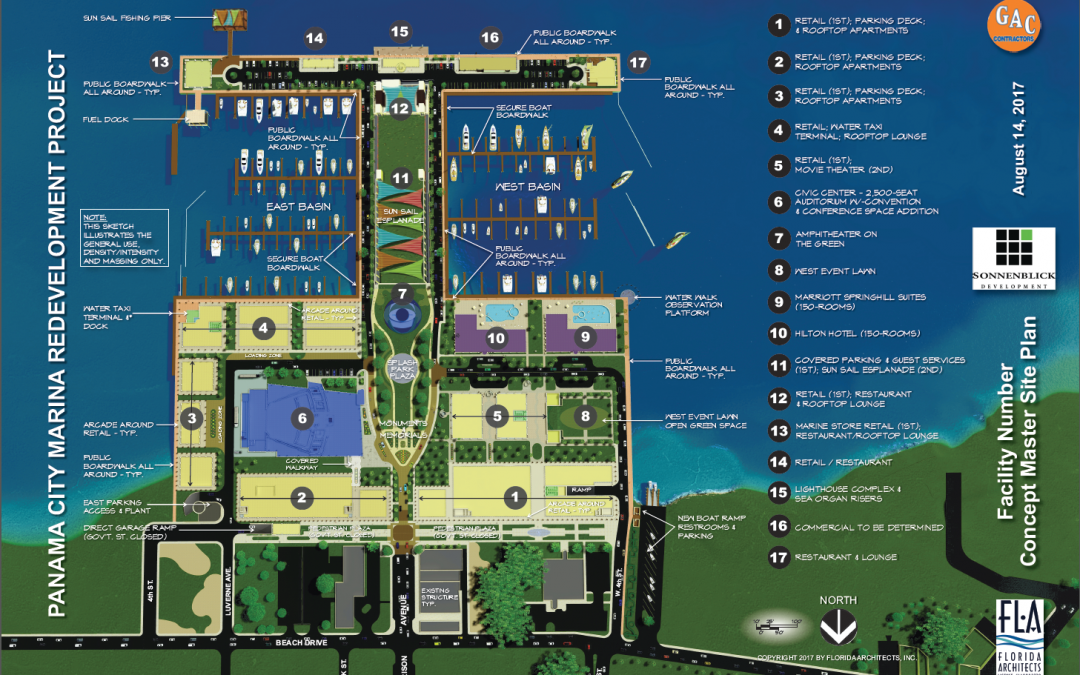By KATIE LANDECK News Herald Reporter
Posted Aug 31, 2017 at 5:43 PMUpdated Aug 31, 2017 at 5:47 PM
A small park, a splash pad, and the promise of trying to recruit a grocery store have been added to the design to appeal to locals hesitant about losing space.
PANAMA CITY — The latest concept plan for the Downtown Panama City Marina, submitted by developer Bob Sonnenblick on Thursday afternoon, is meant to draw in locals and tourists to the massive revitalization project.
A small park, a splash pad and the promise of trying to recruit a grocery store have been added to the design to appeal to locals hesitant about losing space. Inside the public boardwalk that forms the perimeter of the project are retail, parking garages, apartments and two hotels that create a ring around much of the land portion of the project, and a relocated water taxi terminal required the boat ramp to be moved to West Beach Drive. The T-dock keeps the marina store and boardwalk but adds at least two restaurants, a lighthouse complex with a sea organ, and a commercial space with a use that is yet to be determined.
“The concept plan should be viewed as a whole, and not as individual separate uses,” Sonnenblick wrote in his letter to commissioners. “Without all the different uses working together the marina project (as a whole) will not be feasible.”
The proposal, due by Sept. 1, is the first major submission Sonnenblick and his team were required to make under the amended exclusive negotiating agreement (ENA). The goal is “to give the commission a formal opportunity to conceptually approve the use, massing and function of the improvements to be placed on the marina site, subject only to subsequent confirmation,” according to the ENA.
PDF DOCUMENTS
There will be at least two public hearings on the plan, and the commission can choose to conceptually approve the plan, approve with conditions, modify or deny the plan. However, to move forward with letters of intent and feasibility studies, Sonnenblick said he would “need” a favorable vote.
In his letter, Sonnenblick highlights how different pieces of the plan could become “assets” to the community, helping to buoy economic growth and tourism.
For example, he explains the 150,000 feet of retail space — one of the most controversial elements of the plan — could include local stores and fill community needs such as a long-hoped-for grocery store.
Our belief is that visitors will travel for an hour to a destination retail shopping district provided there are a variety of quality retail stores there,” Sonnenblick wrote, adding he expects gross sales revenues of more than $60 million. “Although visitors to Bay County will be attracted to this retail shopping district, it is our intention to also include local stores that would serve residents (who live in) the downtown area or nearby.”
He also wrote that in addition to the apartment spaces he proposed, which would be above the retail space and parking garages, the city should “explore providing incentive to entice other developers” to build downtown.
Feasibility studies still have to be completed to iron out the finances and logistics, but Sonnenblick said he believes the plan will be successful. He noted he believes the city’s infrastructure is adequate, including water, sewer and the road grid.
Sonnenblick has said he plans to be in town Sept. 11 for the first public meeting on the plan.


